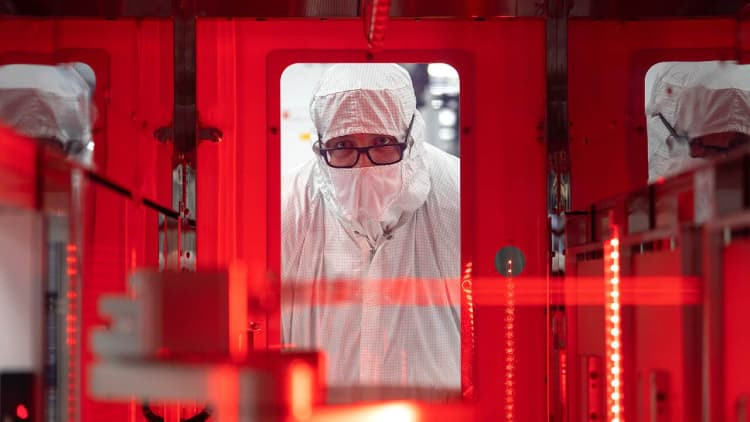Texas Instruments Chip Investment Hits $60 Billion
In The News | 26-06-2025 | By Robin Mitchell

Key Takeaways:
- Texas Instruments is investing over $60 billion to expand semiconductor production across seven sites in the U.S., marking the largest such investment in foundational chip manufacturing in American history.
- The expansion is strategically backed by major tech partners including Apple, NVIDIA, and SpaceX, and is expected to generate around 60,000 new jobs while strengthening U.S. supply chain resilience.
- Production is already underway or ramping at several key facilities, including Sherman, Richardson, and Lehi, supporting high-volume output of analog and embedded processing chips.
- Political uncertainty and international competition remain critical challenges, as shifting government support and pressure from Chinese chipmakers shape the future of the industry.
Once considered a background industry, semiconductor manufacturing has rapidly become a central pillar of national strategy. The pandemic-era chip shortages revealed how deeply modern life depends on these tiny components—and how vulnerable the global supply chain truly is. Since then, the race to secure semiconductor independence has accelerated, with governments and corporations funnelling billions into domestic production.
What triggered this wave of funding, how are nations competing in the so-called chip war, and what does Texas Instruments’ $60 billion pledge reveal about the future of global semiconductor policy?
The Ongoing Semiconductor Funding War
Over the past few years, the world has come to realise what most insiders have known for decades: semiconductors are at the heart of everything, from the smartphones in our pockets to the machinery of national defence.
There is no longer any debate about their importance. If there was any doubt, it was erased by the COVID-19 pandemic. Overnight, it became clear how fragile the semiconductor supply chain really is. Chip shortages forced car production lines to halt, stores to run out of stock, and raised serious questions about the vulnerabilities of the globalised just-in-time manufacturing model.
The pandemic was just the tip of the iceberg. As the US-China trade war escalates, semiconductors have shifted from being obscure technical components to crucial pawns in a tense geopolitical struggle. Tariffs, export restrictions, and political manoeuvring have tightened control over key supply chains, prompting governments worldwide to ensure a steady flow of silicon.
It is no secret that countries are now striving for semiconductor sovereignty, not just for economic reasons but for technological security. This shift has triggered a wave of rapid funding in the industry. The US is leading with the CHIPS Act, pushing hard to bring manufacturing back home. The UK and EU have launched their own initiatives, with the European Commission aiming not only to catch up but also to become a significant player in the advanced chip market.
Meanwhile, China is intensifying its efforts, often outspending others, with the goal of building chip giants that are independent of foreign policies.
A fitting saying goes, "The price of water is not felt until the well runs dry." In the case of semiconductors, the well isn't drying up again; it's being refilled, and every government with a stake in the digital future is opening the funding spigots.
Texas Instruments Announces $60 Billion Investment in U.S. Chip Production Facilities
Texas Instruments, a global semiconductor giant, has announced it will invest over $60 billion to build or expand chip production facilities across the United States. The investment will focus on seven facilities located in Texas and Utah, with the project expected to create approximately 60,000 new jobs.
The bulk of this funding will go towards TI’s Sherman, Texas site, where four new fabrication plants—SM1 through SM4—are planned. Notably, SM1 is expected to begin production within the year, marking a rapid three-year turnaround from initial construction to output. This approach reflects TI’s strategy of building scalable, 300mm wafer fabs to meet long-term demand for analog and embedded processing chips used in industries ranging from healthcare to aerospace.
The Dallas-based company described this as the largest investment in foundational semiconductor manufacturing in the US. However, TI has not provided a detailed timeline for when the full investment will be completed.
Progress Across Key Sites Despite Unclear Completion Timeline
Despite the lack of a definitive timeline, TI’s announcement includes significant progress across multiple sites. In addition to Sherman, production ramping is underway at Richardson, Texas (RFAB2) and Lehi, Utah (LFAB1), further cementing the company’s role in bolstering domestic semiconductor output. These facilities are expected to produce hundreds of millions of chips daily upon reaching full capacity.
This announcement forms part of a broader industry effort to increase domestic chip production following ongoing government initiatives to encourage onshore manufacturing. It comes shortly after Micron Technology increased its planned US semiconductor investment to $200 billion.
This move is widely viewed as part of a coordinated effort with major technology stakeholders. Companies like Apple and NVIDIA have publicly backed TI’s commitment, citing the importance of local supply chains to national innovation strategies. As Apple CEO Tim Cook remarked, “Texas Instruments’ American-made chips help bring Apple products to life.” Such endorsements enhance the credibility of the initiative and reinforce its alignment with national economic priorities.
Industry Endorsements Meet Political Realities
US Secretary of Commerce Gina Raimondo emphasised the significance of the partnership with Texas Instruments, stating it will strengthen US chip manufacturing capabilities for decades. Some analysts, however, interpret such large-scale investment announcements as partly driven by political pressure from the Trump administration, which prioritised boosting US semiconductor production while expressing concerns over foreign competition and supply chain vulnerabilities.
Further political considerations are evident in the administration’s expressed support for partnerships with firms like TI. While the investment signals bipartisan interest in semiconductor independence, there remains ambiguity around how future policies may impact project continuity. Industry observers point to previous instances of CHIPS Act support being delayed or re-evaluated, underlining the need for stable policy frameworks that encourage long-term investment planning.
The administration also discussed imposing tariffs on imported semiconductors and has threatened to withdraw support for the $52.7 billion CHIPS and Science Act, which was enacted under the Biden administration. Previously, Texas Instruments received a $1.6 billion subsidy from the Biden administration linked to an earlier $18 billion investment plan.
Policy Uncertainty Meets Strategic Market Expansion
Texas Instruments primarily manufactures foundational chips used in a wide range of products, including smartphones, automobiles, and aerospace technologies. The company operates 15 manufacturing sites worldwide and counts major customers such as Apple, SpaceX, and Ford. TI has faced increasing competition from Chinese semiconductor manufacturers, especially in the lower-end chip market, underscoring the strategic importance of this new US investment.
This strategic relevance is further highlighted by partnerships with defence and connectivity providers. SpaceX, for instance, has integrated TI’s 300mm SiGe process technology into its Starlink satellite systems, underlining the chips’ suitability for high-speed data applications in remote environments. The reliance on domestically produced semiconductors enhances national resilience, especially as geopolitical tensions and component shortages continue to disrupt global supply chains.
Does This Funding Pledge Show That Governments Can Help Business?
The recent surge in semiconductor funding, exemplified by Texas Instruments' $60 billion investment pledge, highlights the critical role governments can play in supporting vital industries. Strategic public funding, well-targeted subsidies, and policy frameworks can encourage companies to invest heavily in domestic manufacturing, help secure supply chains, and drive technological innovation. When governments coordinate effectively, they can provide the stability and incentives necessary for long-term industry growth that individual companies alone might hesitate to pursue.
However, history also shows that government involvement is a double-edged sword. Political agendas, shifting priorities, and bureaucratic inefficiencies can undermine the intended benefits of such investments. The semiconductor sector's complex geopolitics means that support measures risk becoming tools for short-term political gain rather than sustainable economic strategy. Instances like the threat to withdraw the CHIPS Act funding or impose tariffs can create uncertainty, which companies find difficult to navigate. Over-reliance on government support may also encourage complacency, reducing the pressure on companies to innovate independently.
Furthermore, competition between countries to secure semiconductor sovereignty can lead to duplicated efforts, resource misallocation, and protectionist policies that ultimately harm the global supply chain. The challenge lies in balancing national interests with the reality that semiconductor manufacturing and innovation are deeply interconnected and global by nature.
In conclusion, government funding and policies can be instrumental in fostering a robust semiconductor industry, provided they are implemented with clear, consistent strategies that prioritise technological advancement and supply chain resilience. The Texas Instruments investment reflects a hopeful example of public and private sectors aligning toward a shared goal. Yet, sustaining this momentum requires governments to act judiciously, eschewing political short-sightedness and focusing on building durable partnerships that can weather future economic and geopolitical shifts.

